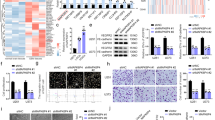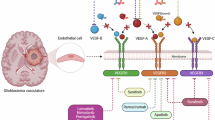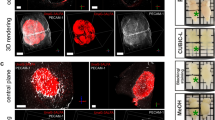Abstract
We recently showed that severe hypoxia was not universally present adjacent to necrosis in human glioma xenografts and spheroids established from the M059K, M006, M006X, M006XLo and M010b cell lines. Using these glioma models, we wished to test whether oxygen serves as a regulator of cellular VEGF expression in situ. In situ hybridization (ISH) and immunohistochemistry (IHC) were used to detect vascular endothelial growth factor (VEGF) mRNA and protein expression in sections of glioma xenografts and spheroids in which hypoxic regions and regions with well-oxygenated necrosis were identified on contiguous sections by use of the hypoxia-specific marker,3H-misonidazole. Independent validation of the presence of radiobiologically hypoxic cells in M006 xenografts was undertaken using the comet assay. Northern blotting analyses of monolayer cells demonstrated significant up-regulation of VEGF mRNA in the M006X line at oxygen concentrations of 6% and below. ISH analysis of VEGF mRNA showed unexpectedly strong staining for VEGF mRNA across the entire viable rim of M006X and M006XLo glioma spheroids. Similarly, in virtually all xenograft tumours of the M059K, M006 and M010b lines, VEGF ISH showed similar staining across all regions of healthy cells up to the border of necrosis. Only in one M006X tumour was there a suggestion of increased VEGF expression in cells adjacent to necrosis. IHC for VEGF showed good concordance with the ISH results. IHC analysis of the VEGF receptor flt-1 showed strong tumour cell staining in M006XLo glioma cells. In human glioma spheroids and xenograft tumours, regions of severe hypoxia do not correspond to areas of up-regulated VEGF expression; in fact, VEGF expression is quite uniform. Furthermore, this and our previous study demonstrate that levels of VEGF expression vary among sublines (M006, M006X and M006XLo) derived from a single human glioma specimen. © 2000 Cancer Research Campaign
Similar content being viewed by others

Article PDF
Change history
16 November 2011
This paper was modified 12 months after initial publication to switch to Creative Commons licence terms, as noted at publication
References
Allalunis-Turner MJ, Day, III RS, McKean JDS, Petruk KC, Allen PB, Aronyk KE, Weir BK, Huyser-Wierenga D, Fulton DS and Urtasun RC (1991) Glutathione levels and chemosensitizing effects of buthionine sulfoximine in human malignant glioma cells. J Neuro-Oncol 11: 157–164
Allalunis-Turner MJ, Franko AJ and Parliament MB (1999) Modulation of oxygen consumption rate and VEGF mRNA expression in human malignant glioma cells by hypoxia. Br J Cancer 80: 104–109
Berse B, Brown LF, Van De Water L, Dvorak HF and Senger DR (1992) Vascular permeability factor (vascular endothelial growth factor) gene is expressed differentially in normal tissues, macrophages, and tumors. Mol Biol Cell 3: 211–220
Boocock CA, Charnock-Jones DS, Sharkey AM, McLaren J, Barker PJ, Wright KA, Twentyman P and Smith SK (1995) Expression of vascular endothelial growth factor and its receptors flt and KDR in ovarian carcinoma. J Natl Cancer Inst 87: 506–516
Brogi E, Wu T, Namiki A and Isner JM (1994) Indirect angiogenic cytokines upregulate VEGF and bFGF gene expression in vascular smooth muscle cells, whereas hypoxia upregulates VEGF expression only. Circulation 90: 649–652
Chapman JD (1984) The cellular basis of radiotherapeutic response. Radiat Phys Chem 24: 283–291
Chin K, Kurashima Y, Ogura T, Tajiri H, Yoshida S and Esumi H (1997) Induction of vascular endothelial growth factor by nitric oxide in human glioblastoma and hepatocellular carcinoma cells. Oncogene 15: 437–442
Damert A, Machin M, Breier G, Fujita MQ, Hanahan D, Risau W and Plate KH (1997) Up-regulation of vascular endothelial growth factor expression in a rat glioma is conferred by two distinct hypoxia-driven mechanisms. Cancer Res 57: 3860–3864
Frank S, Hubner G, Breier G, Longaker MT, Greenhalgh DG and Werner S (1995) Regulation of vascular endothelial growth factor expression in cultured keratinocytes. Implications for normal and impaired wound healing. J Biol Chem 270: 12607–12613
Franko AJ, Parliament MB, Allalunis-Turner MJ and Wolokoff BG (1998) Variable presence of hypoxia in M006 human glioma spheroids and in spheroids and xenografts of clonally derived sublines. Br J Cancer 78: 1261–1268
Germano IM, Ito M, Cho KG, Hoshino T, Davis RL and Wilson CB (1989) Correlation of histopathological features and proliferative potential of gliomas. J Neurosurg 70: 701–706
Gnarra JR, Zhou S, Merrill MJ, Wagner R, Krumm A, Papavassiliou E, Oldfield EH, Klausner RD and Linehan WM (1996) Post-transcriptional regulation of vascular endothelial growth factor mRNA by the product of the VHL tumor suppressor gene. Proc Natl Acad Sci USA 93: 10589–10594
Goldberg MA and Schneider TJ (1994) Similarities between the oxygen-sensing mechanisms regulating the expression of vascular endothelial growth factor and erythropoietin. J Biol Chem 269: 4355–4359
Hochachka PW, Buck LT, Dahl CJ and Land SC (1996) Unifying theory of hypoxia tolerance: molecular/metabolic defense and rescue mechanisms for surviving oxygen lack. Proc Natl Acad Sci USA 93: 9493–9498
Iliopoulos O, Levy AP, Jiang C, Kaelin WG Jr and Goldberg MA (1996) Negative regulation of hypoxia-inducible genes by the von Hippel–Lindau protein. Proc Natl Acad Sci USA 93: 10595–10599
Jiang B-H, Semenza GL, Bauer C and Marti HH (1996) Hypoxia-inducible factor 1 levels vary exponentially over a physiologically relevant range of O2tension. Am J Physiol 271 (Cell Physiol. 40): C1172–C1180
Kennedy AS, Raleigh JA, Perez GM, Calkins DP, Thrall DE, Novotny DB and Varia MA (1997) Proliferation and hypoxia in human squamous cell carcinoma of the cervix: first report of combined immunohistochemical assays. Int Radiat Oncol Biol Phys 37: 897–905
Koch CJ, Howell RL and Biaglow JE (1979) Ascorbate anion potentiates the cytotoxicity of nitro-aromatic compounds under hypoxic and anoxic conditions. Br J Cancer 39: 321–329
Koch CJ, Evans SM and Lord EM (1995) Oxygen dependence of cellular uptake of EF5 [2-(2-nitro-1H-imidazol-1-y1)-N-(2,2,3,3,3-pentafluoropropyl) acetamide]: analysis of drug adducts by fluorescent antibodies versus bound radioactivity. Br J Cancer 72: 869–874
Leith JT and Michelson S (1995) Secretion rates and levels of vascular endothelial growth factor in clone A or HCT-8 human colon tumor cells as a function of oxygen concentration. Cell Prolif 28: 415–430
Levy AP, Levy NS, Loscalzo J, Calderone A, Takahashi N, Yeo KT, Koren G, Colucci WS and Goldberg MA (1995 a) Regulation of vascular endothelial growth factor in cardiac myocytes. Circ Res 76: 758–766
Levy AP, Levy NS, Wegner S and Goldberg MA (1995 b) Transcriptional regulation of the rat vascular endothelial growth factor gene by hypoxia. J Biol Chem 270: 13333–13340
Levy AP, Levy NS and Goldberg MA (1996) Hypoxia-inducible protein binding to vascular endothelial growth factor mRNA and its modulation by the von Hippel–Lindau protein. J Biol Chem 271: 25492–25497
Levy AP, Levy NS, Iliopoulos O, Jiang C, Kaelin WG Jr and Goldberg MA (1997) Regulation of vascular endothelial growth factor by hypoxia and its modulation by the von Hippel–Lindau tumor suppressor gene. Kidney Int 51: 575–578
Li J, Perrella MA, Tsai JC, Yet S, Hsieh CM, Yoshizumi M, Patterson C, Endege WO, Zhou F and Lee ME (1995) Induction of vascular endothelial growth factor gene expression by interleukin-1 beta in rat aortic smooth muscle cells. J Biol Chem 270: 308–312
Liu B, Earl HM, Baban D, Shoaibi M, Fabra A, Kerr DJ and Seymour LW (1995) Melanoma lines express VEGF receptor KDR and respond to exogenously added VEGF. Biochem Biophys Res Commun 217: 721–727
Olive PL, Horsman M, Grau C and Overgaard J (1997) Detection of hypoxic cells in a C3H mouse mammary carcinoma using the comet assay. Br J Cancer 76: 694–699
Olive PL, Johnston PJ, Banath JP and Durand RE (1998) The comet assay: a new method to examine heterogeneity associated with solid tumors. Nat Med 4: 103–105
Parliament MB, Franko AJ, Allalunis-Turner MJ, Mielke BW, Santos CL, Wolokoff BG and Mercer JR (1997) Anomalous patterns of nitroimidazole binding adjacent to necrosis in human glioma xenografts: possible role of decreased oxygen consumption. Br J Cancer 75: 311–318
Plate KH, Breier G, Weich HA and Risau W (1992) Vascular endothelial growth factor is a potential tumour angiogenesis factor in human gliomas in vivo. Nature 359: 845–848
Plate KH, Breier G, Weich HA, Mennel HD and Risau W (1994) Vascular endothelial growth factor and glioma angiogenesis: coordinate induction of VEGF receptors, distribution of VEGF protein and possible in vivo regulatory mechanisms. Int J Cancer 59: 520–529
Raleigh JA, Calkins-Adams DP, Rinker LH, Ballenger CA, Weissler MC, Fowler WC Jr, Novotny DB and Varia M (1998) Hypoxia and vascular endothelial growth factor expression in human squamous cell carcinomas using pimonidazole as a hypoxia marker. Cancer Res 58: 3765–3768
Ryuto M, Ono M, Izumi H, Yoshida S, Weich HA, Kohno K and Kuwano M (1996) Induction of vascular endothelial growth factor by tumor necrosis factor α in human glioma cells. J Biol Chem 271: 28220–28228
Shima DT, Deutsch U and D'Amore PA (1995) Hypoxic induction of vascular endothelial growth factor (VEGF) in human epithelial cells is mediated by increases in mRNA stability. FEBS Lett 270: 203–208
Shweiki D, Itin A, Soffer D and Keshet E (1992) Vascular endothelial growth factor induced by hypoxia may mediate hypoxia-initiated angiogenesis. Nature 359: 843–845
Stein I, Neeman M, Shweiki D, Itin A and Keshet E (1995) Stabilization of vascular endothelial growth factor mRNA by hypoxia and hypoglycemia and coregulation with other ischemia-induced genes. Mol Cell Biol 15: 5363–5368
Urtasun RC, Koch CJ, Franko AJ, Raleigh JA and Chapman JD (1986) A novel technique for measuring human tissue pO2at the cellular level. Br J Cancer 54: 453–457
Vaisman N, Gospodarowicz D and Neufeld G (1990) Characterization of the receptors for vascular endothelial growth factor. J Biol Chem 265: 19461–19466
Waleh NS, Brody MD, Knapp MA, Mendonca HL, Lord EM, Koch CJ, Laderoute KR and Sutherland RM (1995) Mapping of the vascular endothelial growth factor-producing hypoxic cells in multicellular tumor spheroids using a hypoxia-specific marker. Cancer Res 55: 6222–6226
Wang GL, Jiang B-H, Rue EA and Semenza GL (1995) Hypoxia-inducible factor 1 is a basic-helix-loop-helix-PAS heterodimer regulated by cellular O2tension. Proc Natl Acad Sci USA 92: 5510–5514
White FC, Carroll SM and Kamps MP (1995) VEGF mRNA is reversibly stabilized by hypoxia and persistently stabilized in VEGF-overexpressing human tumor cell lines. Growth Factors 12: 289–301
Wizigmann-Voos S, Breier G, Risau W and Plate KH (1995) Up-regulation of vascular endothelial growth factor and its receptors in von Hippel–Lindau disease associated and sporadic hemangioblastomas. Cancer Res 55: 1358–1364
Author information
Authors and Affiliations
Rights and permissions
From twelve months after its original publication, this work is licensed under the Creative Commons Attribution-NonCommercial-Share Alike 3.0 Unported License. To view a copy of this license, visit http://creativecommons.org/licenses/by-nc-sa/3.0/
About this article
Cite this article
Parliament, M., Allalunis-Turner, M., Franko, A. et al. Vascular endothelial growth factor expression is independent of hypoxia in human malignant glioma spheroids and tumours. Br J Cancer 82, 635–641 (2000). https://doi.org/10.1054/bjoc.1999.0975
Received:
Revised:
Accepted:
Published:
Issue date:
DOI: https://doi.org/10.1054/bjoc.1999.0975
Keywords
This article is cited by
-
Bevacizumab changes vascular structure and modulates the expression of angiogenic factors in recurrent malignant gliomas
Brain Tumor Pathology (2016)
-
Hypoxic regulation of cytoglobin and neuroglobin expression in human normal and tumor tissues
Cancer Cell International (2010)
-
Protein tyrosine phosphatases in glioma biology
Acta Neuropathologica (2010)
-
The Emerging Role of Anti-Angiogenic Therapy for Malignant Glioma†
Current Treatment Options in Oncology (2008)
-
Expression of VEGF and its receptor genes in intracranial schwannomas
Journal of Neuro-Oncology (2007)


